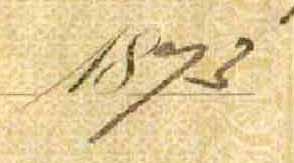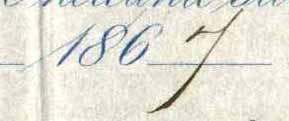Dates cataloged and explained
Database display
Dates are displayed in the online database in a manner to mimic the way they appear on certificates. They represent dates certificates were issued. The do NOT represent the dates certificates were cancelled.
Oftentimes, the printed portions of dates signal more significant changes elsewhere in certificate designs; printed dates simply serve as the easiest ways to discriminate between some varieties. The handwritten, typed, or rubber-stamped portions of dates are enclosed in parentheses as shown in the illustration below.
| Example |
Cataloged as |
 |
18(73) |
 |
186(7) |
 |
189(3) |
 |
190(2) |
 |
(1946) |
Inaccurately reported dates
It is not uncommon to encounter sales offerings that quote dates that do not seem to fit listings already in the database. This often causes collectors to wonder whether they might have discovered new certificate varieties. Dates reported by sellers can sometimes help in discovering new varieties. Conversely, a variety of reported dates, correct and otherwise, can cause confusion.
New varieties
Printed portions of dates or even the full dates of issuance CAN divulge new varieties. If collectors believe they may have found new varieties after re-examining certificate descriptions and existing serial numbers in the database, please write. Be sure to include an image of your certificate. New discoveries are unearthed all the time by this method. Do NOT be afraid to ask!
Images of certificate disagree with descriptions
Sellers may say they are selling certificate with certain dates, but their images may show serial numbers far out of the range of certificates already listed in the database. This is somewhat normal because many sellers still insist on using use stock images as illustrations. It is true that displaying stock images saves time for sellers. On the other hand, stock images force collectors to buy blind. That might be okay for cheap, commodity items. It is not okay for scarcer certificates.
If buyers are ever concerned about whether they will receive the exact certificate illustrated, they should simply email sellers and ask. Yes, I know, it takes time to write and it is inconvenient. But it takes more time and more inconvenience to return unsatisfactory purchases. Stock images are meant to look good on screen. And you may even receive a better certificate than the one shown. But ... you might not!
Dates reported from the backs of certificates

Back of stock certificate sold under probate and cancelled in 1912 about nine years after issuance.
Although uncommon, I have seen items offered for sale on eBay described with impossibly late dates. If items are relatively scarce, then it is unlikely that sellers are using stock images. Instead, they are probably reporting cancellation dates (for stock certificates) or redemption dates (for bonds). Again, ask sellers to clarify.
Mis-interpreted or missing dates
 1902 issue date obliterated by punch cancellations, but determined from registration date elsewhere on the certificate.
1902 issue date obliterated by punch cancellations, but determined from registration date elsewhere on the certificate.
Handwritten dates are frequently problematic . Bad handwriting and faded inks will always cause confusions with issuance dates. That is not going to change. As long as serial numbers are visible, collectors can look at serial numbers already displayed in the certificate database and estimate when certificates were really issued. Unfortunately, it is not unusual to find both issuance dates and serial numbers are both illegible, or at least open to mis-interpretation.
In some cases, issuance dates are covered by rubber stamp cancellations or were accidentally removed by punch cancellations. Surrounding serial numbers will usually allow identification dates to within a few years. On stock certificates, registration dates can help, if present.
Missing dates, missing share-values, and even missing signatures are not especially uncommon on legitimately-issued stock certificates.
Incorporation dates
Although not common, I have seen a few amateur sellers report incorporation dates instead of issuance dates.
Dates of unissued certificates

Collectors call unissued certificates "remainders" because certificate were never issued; they remained in books of stock certificates after companies failed or were merged. Sellers of remainders frequently like to quote precise dates of production. Since remainders were never issued, sellers waste time researching and reporting incorporation dates. While certificates may have been printed within a month or two of incorporation, they may have been printed many years later. Reporting printed dates, such as "18__" or "19__" seems the easiest, simplest, and least deceptive method to advertise remainders.
The certificate shown at right is an unissued remainder #41 from the Bear Creek & Western Railway Co incorporated in Montana. Based on records compiled by dealer Scott Winslow and contributed to this project, we know that certificate #3 was issued in 1909. (Serials #1 and #2 are currently unknown.) Therefore, we can guess that this certificate was probably printed in 1909 or possibly late in 1908.